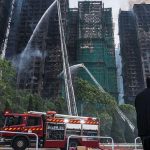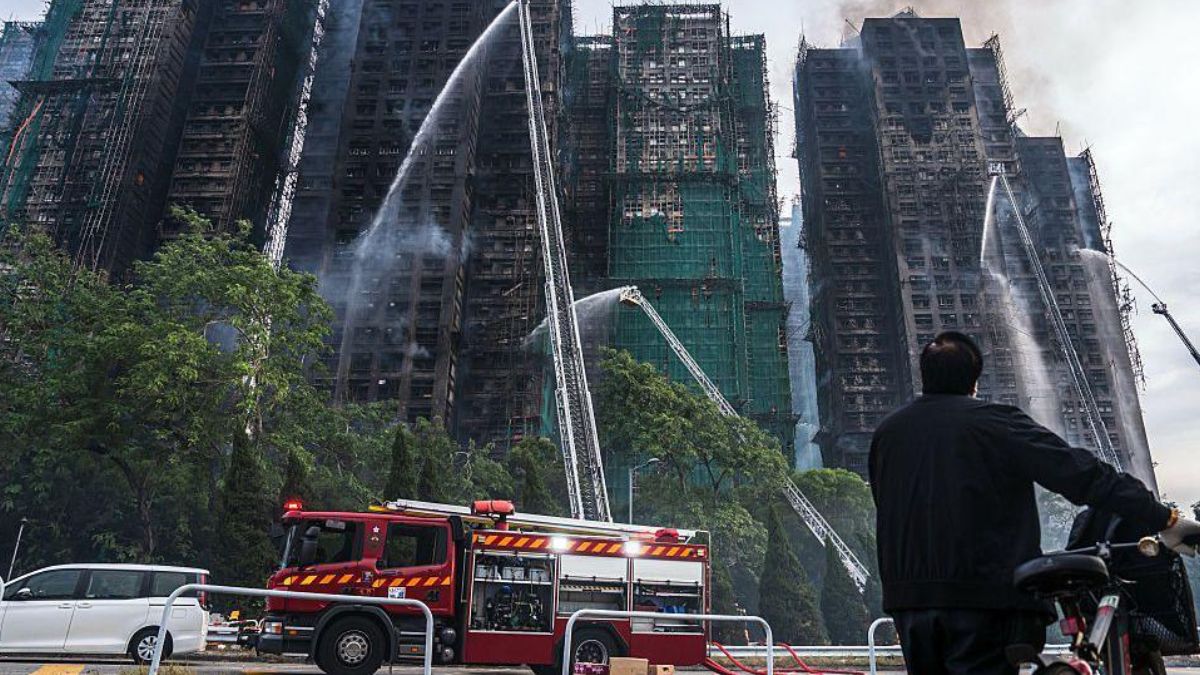A devastating fire in Hong Kong has claimed the lives of at least 55 people, with hundreds still unaccounted for, prompting one of the largest emergency responses the city has seen in decades. Although authorities announced that the blaze was now “under control,” the aftermath has revealed a disaster of staggering scale, leaving residents fearful, families searching for loved ones, and officials grappling with the sheer complexity of the crisis.
The fire broke out early Tuesday morning in a high-density district known for its aging residential towers and maze of subdivided flats. Initial reports indicate that the blaze started on the lower floors of a 38-story mixed-use building before quickly spreading through ventilation shafts, electrical conduits, and flammable interior renovations that had accumulated over years. Witnesses described seeing flames shoot up the facade within minutes, trapping residents on higher floors and sending thick plumes of smoke that engulfed nearby streets.
Emergency services were deployed within minutes, but firefighters encountered severe challenges. Narrow streets, morning traffic, and debris falling from the burning structure slowed access to the building. Inside, rescuers found hallways blocked by collapsed ceilings and twisted metal, while stairwells were filled with heat and smoke that made navigation treacherous. Firefighters used thermal-imaging cameras and drones to detect hotspots, but officials estimate that a full search of the building could take several more days.
Hong Kong’s Fire Services Department confirmed that 55 bodies have been recovered, many from upper floors where residents had crowded near windows in desperate attempts to breathe fresh air. Families gathered at nearby hospitals and temporary shelters, anxiously awaiting updates. Some held up photographs of missing relatives as volunteers attempted to help connect people to municipal databases tracking survivors. For many, the wait has been agonizing.
Authorities say the number of missing could still rise as they reconcile overlapping lists from hospitals, shelters, and residents’ associations. In some cases, entire households have not been accounted for, raising fears that the death toll could climb significantly. “We are doing everything possible,” said a spokesperson from the Fire Services Department. “But the building’s interior conditions are extremely hazardous. Safety protocols prevent us from rushing in without proper assessment.”
The Chief Executive of Hong Kong held a press conference late Tuesday afternoon, calling the tragedy “one of the darkest days in our city’s recent memory.” He pledged full government support for survivors, including temporary accommodation, medical care, and emergency funds for families who lost homes or loved ones. Officials have also ordered a comprehensive investigation into the cause of the fire, though early theories point to an electrical fault or overloaded wiring in one of the lower-floor commercial units.
Residents of the neighborhood say the building had long been a source of concern. Many of its flats were subdivided into smaller units rented largely to low-income families and migrant workers. “We’ve complained for years,” said one resident. “The wiring was old, and there were so many units packed together. It was an accident waiting to happen.” Local NGOs echoed the sentiment, urging authorities to finally address what they call dangerous living conditions endemic to older districts.
By midday, firefighters reported that the blaze was “under control,” but smoldering pockets remained throughout the structure. Specialists were deployed to assess the risk of collapse. The intense heat of the fire had weakened steel supports and caused walls to buckle, prompting concerns that some sections of the building could give way as rescuers continued their search.
As the sun set, makeshift memorials began appearing on sidewalks near the scene—flowers, candles, and handwritten notes expressing grief for the victims and hope for the missing. The emotional toll on the city is palpable. Public transportation in the area has been disrupted, schools have suspended classes, and local businesses have offered free meals and shelter to displaced residents. Volunteers from multiple organizations have stepped forward to distribute masks, blankets, and water.
International responses have also begun pouring in, with several governments offering technical assistance or sending messages of condolence. The tragedy has sparked global discussions about fire safety in densely populated urban environments, particularly in aging high-rise buildings.
For now, however, Hong Kong remains focused on the most urgent task: finding the missing. As firefighters continue combing through the charred structure, families wait with growing dread. Despite reassurances from authorities that the operation will continue until every floor is searched, many fear the worst. Still, amid the devastation, acts of bravery continue to emerge—neighbors helping each other escape, firefighters risking their lives to reach isolated pockets of survivors, and communities rallying together to support strangers.
The road to recovery will be long. In the coming days, questions will intensify about how such a tragedy could unfold in a city known for strict building regulations and advanced emergency services. But for now, Hong Kong is united in grief, searching for answers, and hoping for the safe return of those still missing.
Journalist Details
Latest entries
 NewsDecember 17, 2025Special Intensive Revision 2026: Draft Electoral Roll Published Across West Bengal
NewsDecember 17, 2025Special Intensive Revision 2026: Draft Electoral Roll Published Across West Bengal NewsDecember 11, 2025Court Refuses Interim Bail to Luthras as Thailand Moves Ahead With Deportation Plans of Goa Club Owners
NewsDecember 11, 2025Court Refuses Interim Bail to Luthras as Thailand Moves Ahead With Deportation Plans of Goa Club Owners Latest NewsNovember 27, 2025Hong Kong Inferno Claims More Than 55 Lives as Search Efforts Continue for Hundreds Missing
Latest NewsNovember 27, 2025Hong Kong Inferno Claims More Than 55 Lives as Search Efforts Continue for Hundreds Missing NewsNovember 19, 2025Deported Gang Leader Anmol Bishnoi Brought Back to India; NIA Begins High-Stakes Probe Into Baba Siddique Murder Plot
NewsNovember 19, 2025Deported Gang Leader Anmol Bishnoi Brought Back to India; NIA Begins High-Stakes Probe Into Baba Siddique Murder Plot

